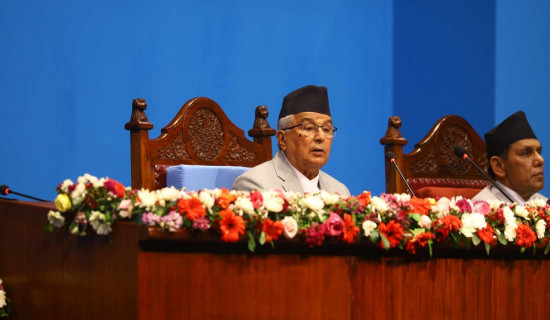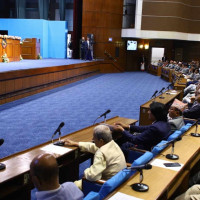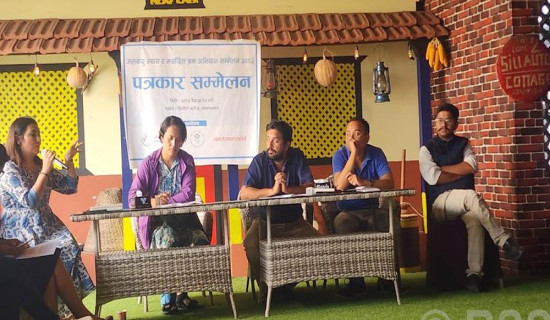- Saturday, 3 May 2025
Addressing Burden Of Childhood Pneumonia
Childhood pneumonia remains a significant global health challenge, particularly in low- and middle-income countries (LMICs). Despite advances in vaccines, antibiotics, and public health measures, pneumonia continues to be the leading infectious cause of mortality in children under five. According to the World Health Organization (WHO), pneumonia accounts for nearly 14 per cent of deaths in children under five, with the highest burden in sub-Saharan Africa and South Asia. While high-income countries have largely controlled childhood pneumonia through vaccination and healthcare access, LMICs still struggle with late diagnoses and inadequate treatment.
The epidemiology of childhood pneumonia is influenced by a combination of biological, environmental, and socioeconomic factors. Despite being preventable and treatable, pneumonia continues to claim over 800,000 young lives annually. The disease disproportionately affects children in poor and marginalised communities, where healthcare access, nutrition, and living conditions are suboptimal. Pneumonia is a respiratory infection that inflames the lungs, leading to difficulty in breathing, fever, cough, and chest pain. It can be caused by bacteria, viruses, or fungi, with the most common bacterial pathogens being Streptococcus pneumoniae and Haemophilus influenzae type b (Hib). Viral causes include respiratory syncytial virus (RSV), influenza, and adenoviruses.
Vaccination
Children under five, particularly newborns and malnourished infants, are at the highest risk of severe pneumonia. Risk factors include poor nutrition, lack of vaccination, air pollution, weak immune systems, and delayed treatment. The disease is most deadly when compounded by other illnesses, such as diarrhoea, malaria, and measles. Vaccination is the most effective way to prevent pneumonia-related deaths. The pneumococcal conjugate vaccine (PCV) and Hib vaccine have dramatically reduced pneumonia cases worldwide. However, many children in LMICs still lack access to these vaccines due to affordability and distribution challenges.
Other important vaccines that help prevent pneumonia include measles vaccine, as measles weakens the immune system and increases pneumonia risk. Pertussis (whooping cough) vaccine, which prevents severe respiratory infections. Influenza vaccine reduces the risk of viral pneumonia, and RSV vaccines and monoclonal antibodies are emerging tools to prevent severe RSV-related pneumonia. Governments must strengthen immunisation programmes to ensure universal vaccine coverage, particularly in rural and underserved areas. International organisations, such as Gavi, the Vaccine Alliance, play a crucial role in making vaccines affordable and accessible to low-income nations.
Malnutrition weakens a child’s immune system, making them more susceptible to infections, including pneumonia. Exclusive breastfeeding for the first six months provides essential antibodies that protect against respiratory infections. Breastfeeding also ensures optimal lung development and strengthens the child’s immune system. After six months, a balanced diet rich in vitamins and minerals especially vitamin A, zinc, and iron is crucial for immunity and lung health. Zinc supplementation, in particular, has been shown to reduce pneumonia incidence in young children. Governments and NGOs must invest in nutrition programmes to combat childhood malnutrition, focusing on educating mothers about proper infant feeding and ensuring access to nutritious food.
Another significant risk factor for childhood pneumonia is air pollution. Children exposed to indoor air pollution which is mainly caused by burning biomass fuels (wood, charcoal, dung), tobacco smoke, and poor ventilation are at higher risk of respiratory infections. Outdoor air pollution, particularly in urban areas with high levels of particulate matter (PM2.5) and toxic gases, further exacerbates lung diseases. Delayed diagnosis and treatment are major contributors to pneumonia mortality. Many children in LMICs lack access to healthcare, leading to severe complications before they receive medical attention. Community health programmes can play a vital role in early detection and treatment of pneumonia.
It is essential to training community health workers to recognise pneumonia symptoms (fast breathing, chest in-drawing, fever). Hence, expanding access to antibiotics and oxygen therapy, especially in rural clinics and improving referral systems for severe cases to reach hospitals quickly significantly reduces mortality. Governments should strengthen primary healthcare systems to ensure every child has timely access to pneumonia treatment.
Poor hygiene increases the spread of pneumonia-causing pathogens. Simple measures like handwashing with soap can significantly reduce the risk of respiratory infections. Improved sanitation and clean water access further contribute to disease prevention such as by promoting handwashing habits, especially before eating and after using the toilet and encouraging the use of clean drinking water to prevent infections that weaken immunity. Thus, school-based hygiene programmes have crucial role to educate children about infection prevention. Governments and NGOs should invest in sanitation infrastructure and public awareness campaigns to improve hygiene practices.
Poverty
Poverty is a major determinant of childhood pneumonia risk. Children from low-income families often lack proper nutrition, clean air, vaccines, and healthcare access. Reducing pneumonia mortality requires broader efforts to tackle poverty and improve living conditions. Therefore, it is imperative to expand universal healthcare coverage to ensure affordability of pneumonia treatment. Investing in education programmes for maternal and child health helps reduce pneumonia incidence. Improving housing conditions to reduce overcrowding and pollution exposure brings significant reduction.
Childhood pneumonia is a preventable tragedy that still claims hundreds of thousands of lives each year. By expanding vaccination programmes, improving nutrition, reducing pollution, ensuring early treatment, and promoting hygiene, we can drastically reduce pneumonia-related deaths. Governments, NGOs, and global organisations must prioritise pneumonia prevention as part of broader child health strategies. Every child deserves the right to breathe freely, and it is our collective responsibility to make that a reality.
(Dr. Lohani is the executive director at the Health Concern. lohanis@gmail.com)
















